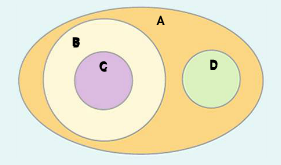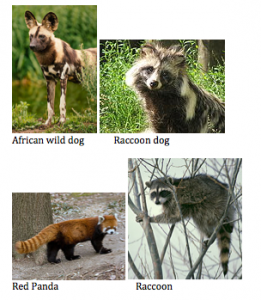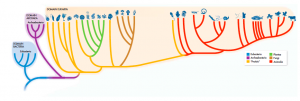Chapter 18.1 Finding Order in Diversity
1. What are the goals of binomial nomenclature?
In binomial nomenclature, each species is assigned a 2 part scientific name
2. How did Linnaeus group species into larger taxa?
Linnaeus also developed a 7 level hierarchical classification system.
Kingdom = the largest most inclusive taxa
Phylum = includes organisms that are different but share important characteristics
Class = similar orders grouped together
Order = closely related families
Family = several genera that share many similarities
Genus = a group of similar species
Species = a group of similar organisms that can interbreed and produce fertile offspring
Examine the Venn diagram below. Each region, A-D, represents members of a taxonomic level. Overlapping or intersecting regions share common members. Regions that do not overlap do not have common members. Use the terms that follow to label the regions shown i the diagram.
Kingdom Chordata
Animalia class Insecta
Phylum class Mammalia
Which pair of organisms do you predict would be most closely related?
- the African wild dog and the raccoon dog or
- the red panda and the raccoon
Examine the table and check your prediction.
|
|||||||||||||||||||||||||||||||||||||||||||||||||||||
On what taxonomic level is your chosen pair related?
What is the most specific taxonomic level shared by all the organisms?
Is the Giant panda more closely related to the red panda or the polar bear? Explain.
Ch 18.2 Modern Evolutionary Classification
What is the goal of evolutionary classification?
The concept of descent with modification led to phylogeny— the study of how living things and extinct things are related to one another.
The goal of phylogenetic systematics (evolutionary classification) is to group species into larger categories that reflect lines of evolutionary descent rather than overall similarities and differences.
Clades are groups of species that include a single common ancestor and all descendants of that ancestor.
This differs from Linnaeus because clades must be a monophyletic group- a single common ancestor and all its descendants.
What is a cladogram?
Review video:
Bozeman science 7:17
https://www.youtube.com/watch?v=ouZ9zEkxGWg
18.3
From Kingdoms to Domains
| Domain | Bacteria | Archaebacteria | Eukarya | Eukarya | Eukarya | Eukarya |
| Kingdom | Eubacteria | Archaebacteria | Protista | Fungi | Plantae | Animalia |
| Cell structures | ||||||
| Number of cells | ||||||
| Mode of nutrition | ||||||
| Examples
|
How are DNA sequences used in classification?
Review Activities and videos:
Classification drag and drop: put taxon levels in order



